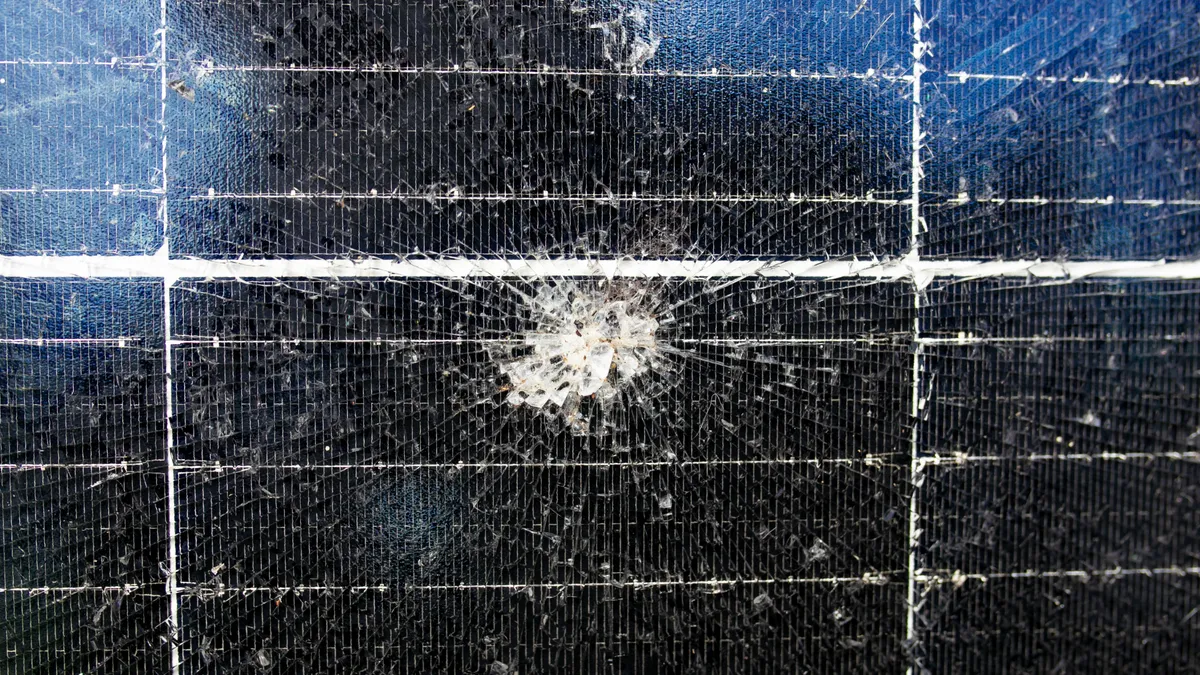Increasingly frequent and severe extreme weather is a reminder to solar power plant owners that it’s critical to have a plan about how to properly dispose of solar panels, long before they think those panels will reach their end-of-life. Why? Because end-of-life can come much sooner than planned. For example, last June, baseball-sized hail traveling at speeds reaching 150 miles per hour destroyed many of the panels at a 5.2-megawatt solar power plant in Nebraska.
A recent study from solar insurer GCube found that hail accounts for 54 percent of solar loss claims, averaging close to $60 million per claim. When natural disasters such as hailstorms strike, solar operators may not have time to figure out what to do and how to pay for solar panel disposal before they face steep fines from government regulators.
But natural disasters aren’t the only reason to proactively craft and update a decommissioning plan for end-of-life or damaged panels. Owners of solar power plants that have gradually reached the end of their useful life need to understand their disposal options and responsibilities, or risk being out of compliance with state or federal regulations.
First, understand the current regulatory environment
Step one in developing an effective solar decommissioning plan is understanding the federal and state regulations that dictate how panels can be disposed of. Though solar panels are not addressed specifically by the federal government, their disposal is governed by the Resource Conservation and Recovery Act (RCRA), which is overseen by the U.S. Environmental Protection Agency (EPA).
In the simplest terms, RCRA identifies waste that always qualifies as hazardous and so must be handled in a manner dictated by the law. Whether panels are hazardous waste or not is a critical distinction; hazardous waste is more expensive to dispose of than waste that can be incinerated or landfilled.
Many solar panels include materials that could qualify them as hazardous waste. “Things that make a solar panel hazardous waste could be if a cadmium telluride (CdTe) panel leaches lead,” said Dwight Clark, director of compliance and recycling technology at Arizona-based We Recycle Solar, a company whose business includes plant decommissioning and panel recycling. “Polycrystalline and monocrystalline panels can also leach materials that would make the panels hazardous waste, like silver and lead and selenium.”
To accurately determine whether solar panels are hazardous, owners must conduct a TCLP (toxicity characteristic leaching procedure) analysis of a representative sample of modules. That representative sample is dictated by ASTM International standards to prevent misleading results; testing only the glass of a solar module, for instance, would say little about possible leaching of dangerous materials. “If something leeches above a certain level, it's hazardous,” Clark said. “That's what the TCLP test determines.”
Changing rules, but a constant need for a decommissioning plan
The EPA is currently developing a proposed rule that would change regulations around the disposal of solar panels. The new regulations, which came in response to a petition from utility and trade groups, are meant to make it easier to recycle and dispose of panels.
To do that, the EPA has proposed solar panels be governed by universal waste rules, a step that California has already taken. “Universal waste is a subset of hazardous waste. It’s for frequently generated, low-hazard waste, like fluorescent light bulbs,” Clark said. “Those rules are developed to promote recycling and provide easy methods for businesses to get rid of this stuff.” Universal waste rules give solar panel owners a year to properly dispose of or recycle panels before incurring a fine.
But there’s an important nuance to universal waste regulations. While universal waste is, by definition, a type of hazardous waste, solar panel owners can still complete TCLP testing to verify that their modules are not hazardous and therefore can be landfilled. “The generator must decide. You can always assume something is hazardous,” Clark said. “A generator who didn't want to spend money on testing can just say, ‘Yeah, I'm going to treat this as hazardous waste.’ But then they're going to spend more money on disposal.”
The right partner can help navigate disposal regulations
The complexities of proper solar panel disposal can feel intimidating at the best of times, but even more so if solar asset owners need to move quickly after a natural disaster. That’s why it’s critical to develop and continuously update a project decommissioning plan.
To ensure compliance and reduce the risk of fines, solar asset owners should consider partnering with a credible and permitted recycler that can perform the necessary sampling and testing. That’s what Clark recommends, especially in an industry where prices and costs can vary dramatically and quickly. “Get a good insurance package. Get a qualified partner and get this figured out,” he said. We Recycle Solar, for instance, is the only company fully permitted by the EPA to properly handle all hazardous secondary materials in solar panels. They also work to extract valuable materials from the panels for recycling.
With the right plan and the right partner, solar asset owners will be prepared and will know how to dispose of their solar panels whenever they reach their end-of-life.
Learn more about partnering with We Recycle Solar for solar panel decommissioning and recycling.










